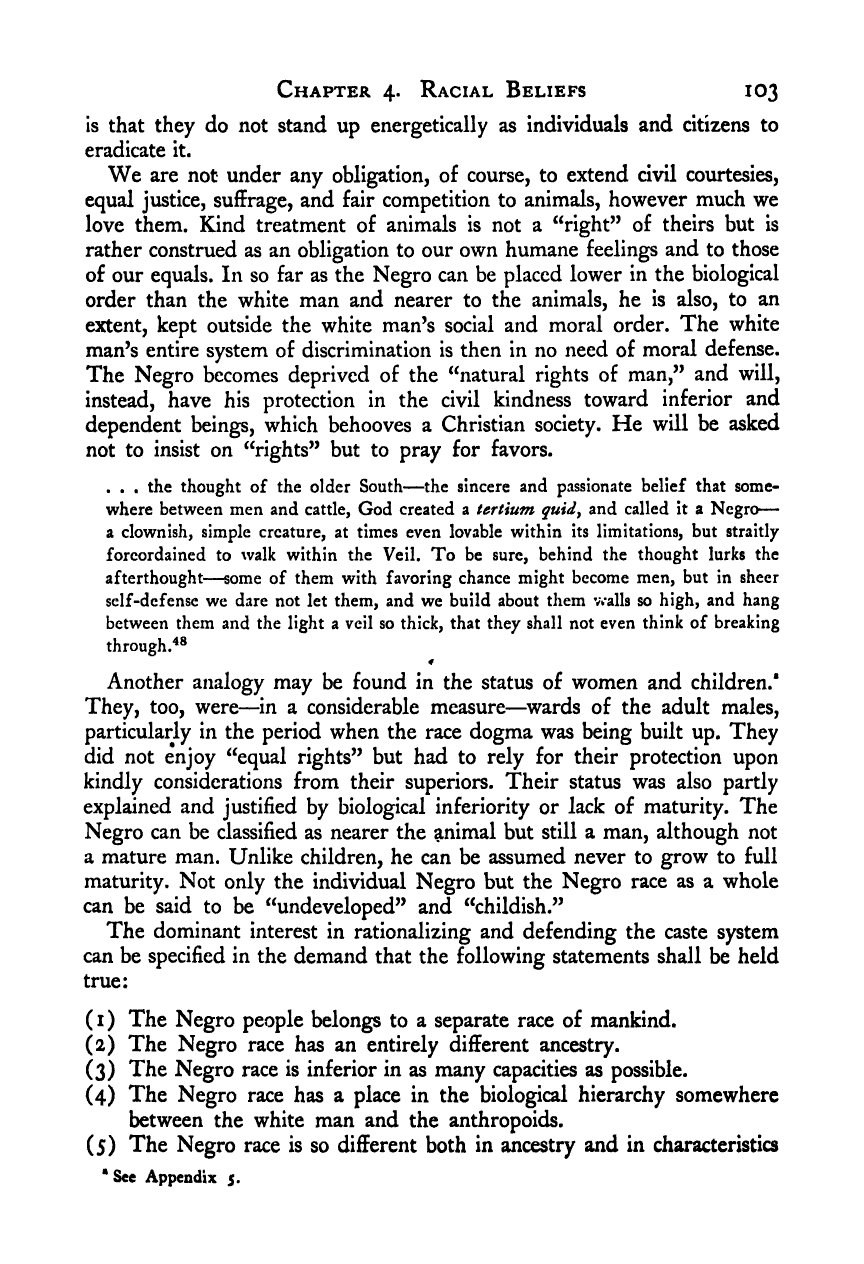Note: Gunnar Myrdal died in 1987, less than 70 years ago. Therefore, this work is protected by copyright, restricting your legal rights to reproduce it. However, you are welcome to view it on screen, as you do now. Read more about copyright.
Full resolution (TIFF) - On this page / på denna sida - II. Race - 4. Racial Beliefs - 7. Beliefs with a Purpose

<< prev. page << föreg. sida << >> nästa sida >> next page >>
Below is the raw OCR text
from the above scanned image.
Do you see an error? Proofread the page now!
Här nedan syns maskintolkade texten från faksimilbilden ovan.
Ser du något fel? Korrekturläs sidan nu!
This page has never been proofread. / Denna sida har aldrig korrekturlästs.
Chapter 4. Racial Beliefs 103
is that they do not stand up energetically as individuals and citizens to
eradicate it.
We are not under any obligation, of course, to extend civil courtesies,
equal justice, suffrage, and fair competition to animals, however much we
love them. Kind treatment of animals is not a “right” of theirs but is
rather construed as an obligation to our own humane feelings and to those
of our equals. In so far as the Negro can be placed lower in the biological
order than the white man and nearer to the animals, he Is also, to an
extent, kept outside the white man’s social and moral order. The white
man’s entire system of discrimination is then in no need of moral defense.
The Negro becomes deprived of the “natural rights of man,” and will,
instead, have his protection in the civil kindness toward inferior and
dependent beings, which behooves a Christian society. He will be asked
not to insist on “rights” but to pray for favors.
. . . the thought of the older South—the sincere and passionate belief that some-
where between men and cattle, God created a tertium quidy and called it a Negro
a clownish, simple creature, at times even lovable within its limitations, but straitly
foreordained to walk within the Veil. To be sure, behind the thought lurks the
afterthought—some of them with favoring chance might become men, but in sheer
self-defense we dare not let them, and we build about them walls so high, and hang
between them and the light a veil so thick, that they shall not even think of breaking
through.’*®
«
Another analogy may be found in the status of women and children.*
They, too, were—in a considerable measure—wards of the adult males,
particularly in the period when the race dogma was being built up. They
did not enjoy “equal rights” but had to rely for their protection upon
kindly considerations from their superiors. Their status was also partly
explained and justified by biological inferiority or lack of maturity. The
Negro can be classified as nearer the animal but still a man, although not
a mature man. Unlike children, he can be assumed never to grow to full
maturity. Not only the individual Negro but the Negro race as a whole
can be said to be “undeveloped” and “childish.”
The dominant interest in rationalizing and defending the caste system
can be specified in the demand that the following statements shall be held
true:
(1) The Negro people belongs to a separate race of mankind.
(2) The Negro race has an entirely different ancestry.
(3) The Negro race is inferior in as many capacities as possible.
(4) The Negro race has a place in the biological hierarchy somewhere
between the white man and the anthropoids.
(5) The Negro race is so different both in ancestry and in characteristics
• See Appendix 5.
<< prev. page << föreg. sida << >> nästa sida >> next page >>